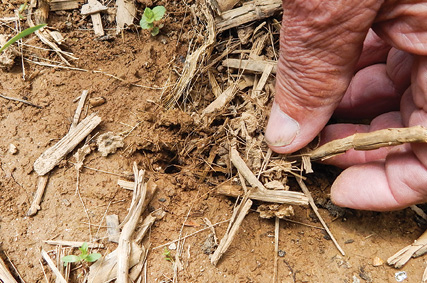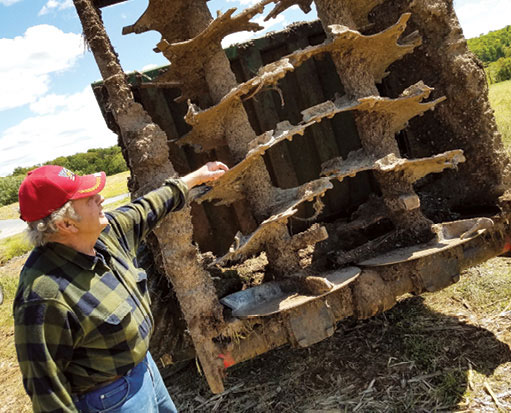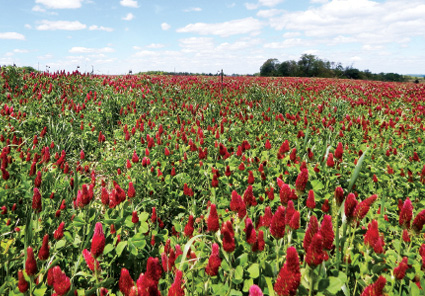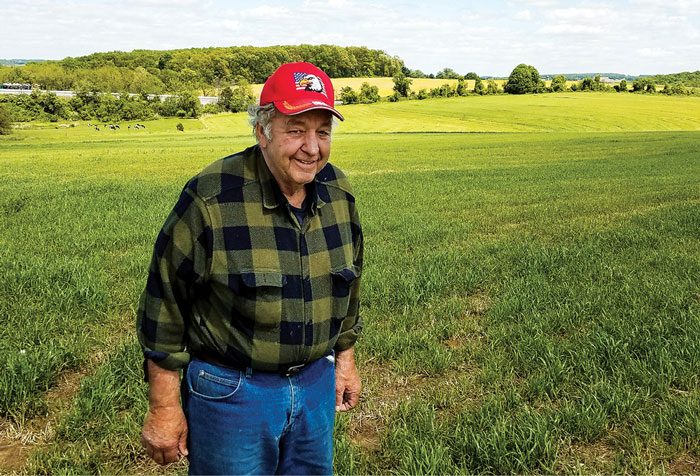Pictured Above: ORGANIC MATTER MASTER. Seven Valleys, Pa., no-tiller Leroy Bupp has made it his focus to raise organic matter levels over the last 30 years. Using a combination of techniques, including long-term cover cropping, planting green and spreading manure, he’s seen a large boost. An average across 150 soil samples pulled from all 700 acres of his farm over the past 4 years show that his organic matter has risen from 2-4.8%.
An ancestor of the Leroy Bupp’s family likely started farming the land in Seven Valleys, Pa. Bupp currently farms on acres that were originally farmed around the time the 13 colonies declared independence from Britain. Of course, much has changed over the years.
Bupp says when farmers in the “new world” first started cutting their plots into the pristine, virgin forest and prairie lands, the soil’s organic matter content was probably around 10%. Over 2½ centuries of farming, especially in the last century with large-scale, full-width tillage, much of the country’s soil organic matter level has languished around 2% and below.
His family’s farm was no different. But Bupp has spent the past 30 years concentrating specifically on restoring organic matter to the soil. Through a combination of long-term no-tilling, cover cropping, planting green and spreading manure, he feels he is well on his way to restoring the land.
An average across 150 soil samples pulled from all 700 acres of his farm over the past 4 years show that his organic matter has risen to 4.8%.
Although proud of his results, he jokes about how he discovered the strategies to achieve them.
“I’m only aware of one other farmer in the area with higher organic matter than me, and that’s Steve Groff — basically the cover crop expert for the East,” he says. “He’s really smart, though, and his results are through things he did intentionally. I got where I am mostly by accident.”
About 25 years ago, long before the practice gained the attention it has now, Bupp adopted cover cropping on most of his acreage because he’d heard that a mat of cereal rye would help support the weight of his manure spreader.
“I have a family friend who was a Holstein breeder and was an early no-tiller and cover cropper,” Bupp says. “Once when I visited his farm, I said, ‘Why do you have all this rye growing?’ He told me that I’d be amazed by how much weight rye will carry when I’m dragging my manure spreader and other equipment across the field, and that reduces compaction when you’re spreading over the winter.
“That’s all I knew when I first started, but once I started seeing all sorts of benefits, I just never stopped.”
Similarly, with planting green, adopting the practice began accidently.
“We used to run a sizeable dairy and I’d have a worker out running my planter while I was busy in the barn,” says Bupp. “I was supposed to get out and spray down the cover crop, but I just didn’t have time, so he started planting before I sprayed. I was worried at first, but my helper came back and said the corn planted great.
“I remember my wife and I looking at the tall rye because we didn’t see the corn pop out of it for almost a month. She kept saying, ‘The slugs are going to get it!’ But it never happened,” he says. “The corn shot up and looked great and we ended up with a 200-plus bushel corn yield that year — which was great for us.
“We’ve been doing it ever since for the past 20 years. I would have never had the guts to try planting green like that on purpose.”
Cultivating Soil Biology
As a purest, most of Bupp’s farm hasn’t seen a disc or plow in 30 years.
Rooted in the economics of fuel savings and fewer trips across the field, Bupp’s biggest reason for not tilling is the destruction it brings to soil biology.

SLIMY SIDEKICKS. Calling them his No. 1 residue eaters, Bupp lauds the ability of night crawlers to dig burrows all the way down to 8 feet deep. The practical upshot of this is that it aerates the soil and helps water infiltrate.
“For a start, tillage destroys a lot of night crawler and earthworm holes and damages the population,” he says. “A lot of night crawlers can dig down deep enough to survive, but most earthworms get chopped.
“Regular earthworms lay about four to six eggs in cocoons made of saliva. They hatch when conditions are right. Tillage has been shown to wipe out around 50% of the live worms and up to 80% of the cocoons.”
Pointing out their propensity to digest crop residue and assist with soil drainage, Bupp has a special place in his heart for these wiggly cohabitants.
“Night crawlers live in the same holes for about 5 to 7 years and they can dig them up to 8 feet deep,” he says. “They’re our No. 1 residue eater.
“When I walk out into my fields, they are just littered with night crawler holes and these things drag all the scraps of residue right down with them. As long as you don’t till, all their holes stick around after they die, too. Just imagine thousands of these holes taking water 8 feet deep when it rains.”
Possibly even more important, Bupp claims a healthy microbial environment can’t build a strong foothold in a tilled environment.
“The fastest way to build organic matter is to have biomass and the microbes to process it,” says Bupp. “Microbes feed on the excretion of carbohydrates from the roots of crops.
“The more the roots grow — and cover crops ensure that something is always growing — the more food the microbes have.
“Then they take these carbohydrates and eat and excrete them several times over and turn them into a fat, which builds organic matter and makes nutrients available for the plants.”
Bupp feels that a buildup of residue has caused some reduced-tillage or no-till farmers to backslide into lightly vertical tilling the first few inches of their soil. He’s thinks this is unnecessary.
“If you have too much residue, there’s something wrong with the biology in the soil,” he says. “It could be maybe too much insecticide or maybe the microbial life, organic matter and worm colonies just aren’t strong enough yet, but tillage will set you back.”

FULL OF MANURE. For spreading manure, Bupp uses a Hydra Ram vertical beater spreader and a 5,200-gallon tank. For many years, he’s been given the suggestion to lightly till manure applications to save ammonia. He believes this to be a bad idea, and that healthy soils will process nutrients from the manure far better if it’s left on the surface undisturbed.
He’s long rebuffed recommendations to lightly till manure applications for this reason as well.
Manure Application
Bupp has backed down a bit from his manure application in recent years since downsizing his dairy operation, but he still occasionally spreads up to 400 acres. He includes some chicken litter as well — about 8 tons of liquid manure per acre and 1.5 to 2 tons of chicken litter per acre.
For this purpose, he uses a Hydra Ram vertical beater spreader and a 5,200-gallon tank for liquid.
“We’ve been told by university professors that we need to till in our manure to save ammonia,” says Bupp. “I no longer believe that, I think it’s incorrect.
“We put our manure on a thick mat of cover crops. Manure is two things: fiber and soluble nutrients. If your soil is aggregated and has healthy biological activity, the liquids will be absorbed and retained and your fiber stays on top. Mother nature didn’t make our soils to be tilled.
“The biology works on the fiber on top, but not if you work it in and oxidize it.”
Bupp points to a university study done over a decade ago that claims farmers can save up to $50 worth of ammonia per acre by lightly tilling their manure applications. He speculates, however, that manure is more effective if allowed to be processed naturally by healthy microbial activity.
“Okay, you can save $50 per acre, but what are you losing by tilling? $75? $100? It’s hard to say, but I’m just about certain leaving it untilled is the better option for us,” says Bupp. “I don’t believe in tilling period. It’s a waste of fuel and it destroys soil health.”
Bupp spreads manure primarily in late fall and early spring as long as the soil is “open” and there’s no snow on the ground.
“The more green growth, the better,” he says.
Bupp feels his entire strategy works because of the level of soil health he’s attained.
“If your soil is healthy, it’ll absorb the nutrients from anything you spread. But it also absorbs and retains moisture so nothing will be lost to runoff,” he says. “That is incredibly important out here with our land that slopes and rolls so much.”
Cover Crops
Bupp’s usual rotation is 2 years of corn broken up by 1 year of soybeans, with wheat and alfalfa occasionally rotated in. When it comes to cover crops, he has been consistently using annual ryegrass. Recently, though, he’s started increasing his use of crimson clover.
“We’re doing a lot of the crimson clover and ryegrass together now. That’s my favorite mix,” Bupp says. “The ryegrass puts an incredible root down and the crimson clover gives us some nitrogen back.”
He says he was sold on annual ryegrass the first year he planted it. He got it seeded in mid-October and it was a snowy winter, but the ground didn’t get a hard freeze.
“I don’t believe in tilling period. It’s a waste of fuel and it destroys soil health…”
The following spring, he used a backhoe to dig down 3 feet in several areas to check the root growth.
“I was down 3 feet and the roots went right past that mark,” Bupp says. “If they can shoot roots down longer than three feet over the winter, that’ll get my attention.”
Although he’d been using red clover, Bupp is starting to like crimson clover more.
“With rye and red clover, we’d get close to growing corn without any fertilizer. But now that I’ve learned more about crimson clover, it seems like it might be better,” he says. “Crimson will produce nitrogen nodules about 2 weeks earlier than red, so by the time in spring when I kill it off, I’ll have probably gotten more back out of it.”
Bupp believes in planting cover crops immediately after harvest — following the combine closely with his 15-foot 750 John Deere no-till drill. It can be tricky to time cover cropping with harvest, but Bupp says it’s just a mindset that a farmer has to adopt if they want to commit to building their soil health.
“Cover cropping is hard to do right at harvest time,” Bupp says. “But you just have to do it if you’re trying to get a benefit.
“You can think outside the box a bit and bring on a part-timer to run your drill, but you just have to find a way and figure it out. For me, drilling works the best, too, because I like to have that seed-to-soil contact.”
Planting Green
After accidentally discovering the planting green practice 20 years ago, Bupp had been nervous about how it would affect yields. The feared drawbacks never materialized, but several important benefits did.
Planting green has helped him get in the field sooner in the spring because the actively growing cover crops suck up more excess moisture. Also, the thick mats help insulate against compaction and erosion.
Bupp admits that the question over whether planting green really helps against slugs is contentious, but on his farm, the results are clear.
“I haven’t had an issue with slugs in 20 years,” he says.
He notes that the theory is if a farmer has an actively growing cover crop in the spring, slugs will be attracted to that and do less damage to the cash crop than they would have had it been the only thing growing at the time.
“Penn State also did some research on this,” he says. “They experimentally planted green into several different types of cover crops.
“They found that the slugs didn’t even really like to eat the corn or soybeans when other crops were available. It turns out that their favorite was cereal rye.
“I’m not saying that if you plant green, you automatically won’t have slugs, but it’s working on my farm.”
After planting into his cover crops in the spring, Bupp says he likes to kill them off as soon as he’s able, but with Roundup Ready Corn, he can stretch it out up to a week afterward.

GENEROUS COVER CROPS. Bupp’s favorite cover crops are crimson clover and annual ryegrass. He used to mix rye and red clover, until he’d heard that crimson clover produces nitrogen nodules about 2 weeks earlier than red clover. He feels that by the time in spring when he kills off his cover crop, he gets more nitrogen back out of crimson clover.
Although he hasn’t changed his procedure much for planting green over the last 20 years, Bupp says quality row cleaners on the planter are essential.
“We have Martin row cleaners on our 12-row White planter, but we’re trying some Yetter SharkTooth row cleaners this year,” he says. “It’s really important to have a good set on the planter.
“The roller crimpers are also very interesting and I’d like to try one, but realistically, all you really need is something that cuts a good opening in the row.”
A Focus on Organic Matter
While many farmers consider their organic matter when looking at their overall soil health, for Bupp, it’s the single-most important factor. He feels that long-term, sustained no-tilling and cover cropping create a virtuous cycle that results in soil that’s aerated, aggregated, fertilized, more absorbent and better drained.
“I don’t think a lot of the researchers and thinkers on this really had a good grip on what soil health was until long-term no-tilling started showing results,” Bupp says. “Cornell University was the first one to stand back and say, ‘Oh, now that we’ve been no-tilling for 10 or 15 years, we have soil health.’
“I know about soil health because I’m an old man. I have my understanding based on experience.”
Over time, soil tests have also started to show that phosphorus and potash levels hold steady on most of Bupp’s acres. He says he hardly needs to apply any because, to some extent, his soil feeds itself.
“If your soil is well aggregated, which starts happening as you climb past 2.2 and 2.4% organic matter, it starts healing itself,” he says.
“Your sands, silts and clays start wrapping around each other and are glued together by proteins called glomalin,” he says. “This makes the particles bigger, so your soil feels like coffee grounds.
“The bigger particles make the soil more absorbent, so it drinks in and retains both more water and nutrients. If you have a cover crop growing, those roots will absorb those nutrients for later release when they die.”
Treating his fertility program more like an art than a science, Bupp says he doesn’t usually get too technical. However, he believes that cover crops and the boost in organic matter/soil health has enabled him to cut back on nitrogen (N) applications as well.
During planting, Bupp dribbles on about 30 pounds of liquid N per acre as a starter. Then he’ll come back and broadcast about 100 pounds of ammonium sulfate, which he says will net him 30 more pounds of N and 30 pounds of sulfur.
“At spraying time, we’ll do another 60 pounds of N, so that’ll give us a total of around 120 pounds per acre,” he says. “If we had a good crimson clover crop, we won’t have to put any more on. But if the corn doesn’t look good, we’ll sidedress another few pounds.”
Bupp’s corn yields average around 200 bushels per acre and his soybean yields ring in at around 50 bushels.
By pushing fertilizer and nutrients, he suspects he could squeeze more out, but he prefers spending less on inputs to pulling in higher yields.
Bupp says one of his favorite quotes in Edward Faulkner’s 1943 book “Plowman’s Folly” sums up his own thinking when he first adopted no-till.
“There is a paragraph in there that goes, ‘If we continue to till our soil with heavy equipment, we will pollute our rivers and bays to the point that the costs of cleaning them up will be astronomical,’” says Bupp. “He wrote that in 1943. It was a best-selling book, but he was laughed at. People said, ‘But we have to till!’
“It’s just not true, and I’m proof of that.”





Post a comment
Report Abusive Comment